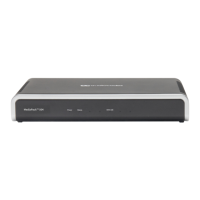SIP User's Manual 436 Document #: LTRT-65415
MediaPack Series
Parameter Description
calling number and Display text (from IP) are sent to the
device's port.
For FXO interfaces, the Caller ID signal is detected and sent to
IP in the SIP INVITE message (as 'Display' element).
For information on the Caller ID table, see Configuring Caller
Display Information on page 155.
To disa
ble/enable caller ID generation per port, see
Configuring Call Forward on page 157.
Web: Caller ID Type
EMS: Caller id Types
[CallerIDType]
Defines one of the following standards for detection (FXO) and
generation (FXS) of Caller ID, and detection (FXO) generation
(FXS) of MWI (when specified) signals:
[0] Standard Bellcore = Caller ID and MWI (default)
[1] Standard ETSI = Caller ID and MWI
[2] Standard NTT
[4] Standard BT = Britain
[16] Standard DTMF Based ETSI
[17] Standard Denmark = Caller ID and MWI
[18] Standard India
[19] Standard Brazil
Notes:
Typically, the Caller ID signals are generated / detected
between the first and second rings. However, sometimes
the Caller ID is detected before the first ring signal (in such
a scenario, configure the parameter RingsBeforeCallerID to
0).
Caller ID detection for Britain [4] is not supported on the
device’s FXO ports. Only FXS ports can generate the Britain
[4] Caller ID.
To select the Bellcore Caller ID sub standard, use the
parameter BellcoreCallerIDTypeOneSubStandard. To select
the ETSI Caller ID substandard, use the parameter
ETSICallerIDTypeOneSubStandard.
To select the Bellcore MWI sub standard, use the parameter
BellcoreVMWITypeOneStandard. To select the ETSI MWI
sub standard, use the parameter
ETSIVMWITypeOneStandard.
If you define Caller ID Type as NTT [2], you need to define
the NTT DID signaling form (FSK or DTMF) using the
parameter NTTDIDSignallingForm.

